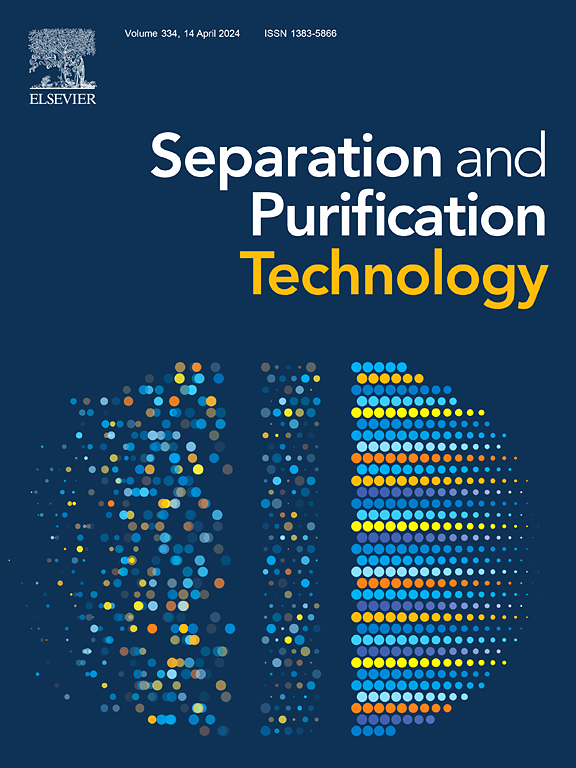Controlled cross-linking and tailored affinity characteristic of Janus silica nanosheets hydrogel via pickering high internal phase emulsions (HIPEs) system for high-accuracy separation of naringin
IF 8.1
1区 工程技术
Q1 ENGINEERING, CHEMICAL
引用次数: 0
Abstract
Selective separation and purification of flavoniods from agricultural wastes has become a prominent topic due to the promising clinical application potential and green and sustainable development needs. Recently, various efforts have been devoted to the development of amphiphilic silica nanosheet sorbents. However, there are still challenges in promoting stable selectivity and rapid mass transfer. Therefore, we prepared a novel hydrogel by embedding Janus silica nanosheets as a stabilized particle into a porous carrier via Pickering HIPEs system. Janus silica nanosheets (J-SNS) with hydrophobic surface (end-capped with vinyl) and hydrophilic surface (end-capped with amino) were prepared by ultrasonication of Janus composite aerogels produced via interfacial sol–gel process. Then, the imprinted polymer was modified onto the hydrophobic surface of J-SNS by precipitation polymerization using naringin (NRG) as the template molecule and 3-acrylamidophenylboronic acid as the functional monomer. Subsequently, chitosan was attached to the hydrophilic surface of J-SNS-MIPs by amidation reaction between citric acid carboxyl group and amino group to enhance the emulsion interface crosslinking polymerization. The prepared PHs@J-SNS-MIPs not only showed fast adsorption (120 min) and excellent enrichment of NRG (40.88 μmol g−1), but also showed good selectivity (imprinting factor 2.76) and regeneration performance (efficiency of 92.04 % after 6 cycles). Additionally, the extraction rate of coarse NRG via PHs@J-SNS-MIPs was 92.28 %. Remarkably, the purified NRG solutions displayed lasting antibacterial performance against Staphylococcus aureus (S. aureus) with inhibition zone of 13.25 mm and 11.06 mm, respectively. Therefore, the PHs@J-SNS-MIPs could be potentially developed as a feasible and efficient sorbent to achieve the goals of green sustainable chemistry for selective separation and purification of high-value natural flavoniods from agricultural wastes.


通过高内相乳剂(HIPEs)系统对Janus二氧化硅纳米片水凝胶的控制交联和定制亲和特性进行了高精度的柚皮苷分离
由于具有广阔的临床应用潜力和绿色可持续发展的需要,从农业废弃物中选择性分离纯化黄酮类化合物已成为一个突出的课题。近年来,人们对两亲性二氧化硅纳米片吸附剂进行了大量的研究。然而,在促进稳定的选择性和快速传质方面仍然存在挑战。因此,我们通过Pickering HIPEs系统将Janus二氧化硅纳米片作为稳定粒子嵌入多孔载体中,制备了一种新型水凝胶。对溶胶-凝胶界面法制备的Janus复合气凝胶进行超声波处理,制备了具有疏水表面(端包乙烯基)和亲水表面(端包氨基)的Janus二氧化硅纳米片(J-SNS)。然后,以柚皮苷(NRG)为模板分子,以3-丙烯酰胺苯硼酸为功能单体,通过沉淀聚合将印迹聚合物修饰在J-SNS疏水表面。随后,通过柠檬酸羧基与氨基之间的酰胺化反应,将壳聚糖附着在J-SNS-MIPs的亲水性表面,增强乳液界面交联聚合。制备的PHs@J-SNS-MIPs不仅吸附速度快(120 min),富集量高(40.88 μmol g−1),而且具有良好的选择性(印迹因子2.76)和再生性能(6次循环后再生效率为92.04 %)。通过PHs@J-SNS-MIPs提取粗NRG的提取率为92.28 %。值得注意的是,纯化后的NRG溶液对金黄色葡萄球菌(S. aureus)具有持久的抑菌效果,抑菌带分别为13.25 mm和11.06 mm。因此,PHs@J-SNS-MIPs有可能成为一种可行的高效吸附剂,实现绿色可持续化学对农业废弃物中高价值天然类黄酮的选择性分离和纯化。
本文章由计算机程序翻译,如有差异,请以英文原文为准。
求助全文
约1分钟内获得全文
求助全文
来源期刊

Separation and Purification Technology
工程技术-工程:化工
CiteScore
14.00
自引率
12.80%
发文量
2347
审稿时长
43 days
期刊介绍:
Separation and Purification Technology is a premier journal committed to sharing innovative methods for separation and purification in chemical and environmental engineering, encompassing both homogeneous solutions and heterogeneous mixtures. Our scope includes the separation and/or purification of liquids, vapors, and gases, as well as carbon capture and separation techniques. However, it's important to note that methods solely intended for analytical purposes are not within the scope of the journal. Additionally, disciplines such as soil science, polymer science, and metallurgy fall outside the purview of Separation and Purification Technology. Join us in advancing the field of separation and purification methods for sustainable solutions in chemical and environmental engineering.
 求助内容:
求助内容: 应助结果提醒方式:
应助结果提醒方式:


